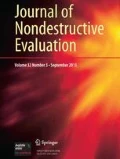Abstract
A SQUID magnetometer can be used to measure the magnetic field produced by flaws in a two-dimensional, conducting plate carrying a current. Identification of the flaw-induced magnetic field is difficult because of the large magnetic field associated with the edges of the plate and the current in the leads that connect the plate to the power supply. We have developed a technique by which the wire and edge fields can be cancelled prior to mapping the magnetic field. In this technique, a similar unflawed conducting sheet is placed adjacent to the flawed plate, with a connection between the sheet and the plate at one edge, and with the opposite edges of the sheet and of the plate connected to the two conductors of a coaxial cable. Thus, an applied current will flow along one conductor of the cable, across the cancelling sheet, cross into the flawed plate, return along the plate, and then return to the power supply along the other conductor of the coaxial cable. As a result of this geometry, there is no magnetic field from the lead-in wires because they are coaxial, and the magnetic field due to the edges of the plate is cancelled by the opposing magnetic field of the edges in the adjacent sheet. The extent of cancellation is determined primarily by the separation between the plate and the cancelling sheet, by the thickness of the plate, and by macroscopic inhomogeneities in their electrical conductivities.
Similar content being viewed by others
References
J. P. Wikswo, Jr., The calculation of the magnetic field from a current distribution: Application to finite element techniques,IEEE Trans. Magnetics, MAG-14: 1076–1077 (1978).
W. R. Smythe,Static and Dynamic Electricity (McGraw Hill, New York, 1939), p. 62.
N. G. Sepulveda, D. J. Staton, and J. P. Wikswo, Jr., A mathematical analysis of the magnetic field produced by flaws in two-dimensional current-carrying conductors,J. Nondest. Eval. 1189–101 (1992).
D. S. Buchanan, D. B. Crum, D. Cox, and J. P. Wikswo, Jr., MicroSQUID: A close-spaced four channel magnetometer, inAdvances in Biomagnetism, S. J. Williamson, M. Hoke, G. Stroink, and M. Kotani, eds. (Plenum, New York, 1990) pp. 677–679.
J. P. Wikswo, Jr., J. M. van Egeraat, Y. P. Ma, N. G. Sepulveda, D. J. Staton, S. Tan, and R. S. Wijesinghe, Instrumentation and techniques for high-resolution magnetic imaging, inDigital Image Synthesis and Inverse Optics, A. F. Gmitro, P. S. Idell, and I. J. LaHaie, eds. (SPIE Proceedings, Vol. 1351, 1990) pp. 438–470.
H. Weinstock, and M. Nisenoff, Nondestructive evaluation of metallic structures using a SQUID gradiometer, inSQUID '85, H. D. Hahlbohm and H. Lubbig, eds. (de Gruyter, Berlin, 1985) pp. 843–847.
Author information
Authors and Affiliations
Rights and permissions
About this article
Cite this article
Wikswo, J.P., Sepulveda, N.G., Ma, Y.P. et al. An improved method for magnetic identification and localization of cracks in conductors. J Nondestruct Eval 12, 109–119 (1993). https://doi.org/10.1007/BF00567567
Received:
Issue Date:
DOI: https://doi.org/10.1007/BF00567567



